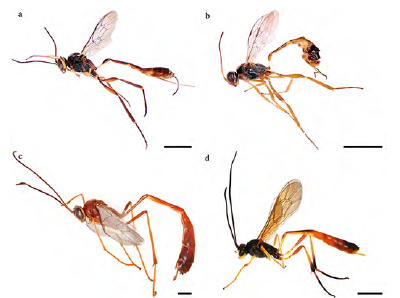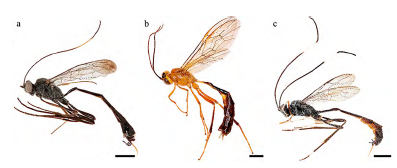The Neotropical Anomaloninae is one of the poorly studied groups within Ichneumonidae, currently with 17 genera occurring on this biogeographical region (Fernandes and Diaz, 2019) of which just PodogasterBrullé, 1846 has species recorded to Colombia (Gauld and Bradshaw, 1997; Yu et al., 2016). Herein we report for the first time to Colombia the genera AphanistesFörster, 1869 and Habronyx Förster, 1869; we also report Castrosion Gauld & Bradshaw, 1997 and Ophiopterus Brullé, 1846 to Peru; and AnomalonPanzer, 1804 to Trinidad and Tobago, besides the first record of three species of Anomalon to Brazil, Peru, and Trinidad and Tobago.
The Colombian specimens examined in this study were collected using manual collection and entomological nets during an inventory carried out in the Colombian Andes, more specifically at the Mesenia-Paramillo nature reserve, department of Antioquia, Colombia (5°29'46.1"N and 75°53'20.5"W) in February, March, April and December 2019. These specimens were deposited in the Universidad de los Andes (UNIANDES) entomological collection (curator: Emilio Rialpe) in Bogota under ANLA collection permit 1177 of specimens of the biological diversity. New distribution records for Brazil, Peru, and Trinidad and Tobago have been incorporated to this manuscript from the observation of specimens belonging to the following institutions (curators in parentheses): MUSM: Museo de Historia Natural, Universidad Nacional Mayor de San Marcos, Lima, Perú (Gerardo Lamas), RMNH: Naturalis Biodiversity Center, Leiden, Netherlands (Frederique Bakker) and LRRP: Instituto Biológico, Ribeirão Preto, São Paulo, Brazil (Nelson W. Perioto).
The information contained in the "Examined material" sections corresponding to the specimen label is organized by country and major geographic regions (regions, states, departments, district, commune, parish or provinces, according to each country). Different collecting events are separated with semicolons. Label data was rearranged, including only the information provided, in the following order: locality, coordinates in sexagesimal degrees, elevation, date, collecting method, collector, and any other information included. Abbreviations were completed; and, if other language than English was employed, it was translated. New distribution records are indicated by an asterisk (*). General morphological terminology follows Broad et al. (2018). Photographs were prepared using a Canon EOS 5D Mark IV and Canon EF 100mm f/2.8 IS USM macro lens for the Colombian specimens, and Canon EOS T3 and Canon EF-S 60 mm macro lens for the Peruvian specimens. All images were later prepared with Adobe Photoshop® (v. 20.0.5).

Figures 1 a-d) Anomaloninae species newly reported in Brazil (a), Trinidad and Tobago (b) and Colombia (c-d) (lateral view). a) Anomalon fuscipes (Cameron); b) A. sinuatum (Morley); c) Aphanistes ruthae Alvarado; d) Habronyx flavus Alvarado. Scale bars = 2.00 mm.
Examined material. BRAZIL: 2 ♀♀, São Paulo, Cravinhos, Fazenda Palmares, Coffee crop, 21°18'54"S/47°47'39"W, Moericke trap (superior), 27.iv.2006, R. I. R. Lara et al. (1 female, LRRP); same locality and data, Moericke trap (inferior), 07.ii.2007, (1 female, LRRP).
Distribution. Costa Rica (Gauld and Bradshaw, 1997), Mexico (Townes and Townes, 1966), Peru (Alvarado et al., 2014) and *Brazil.
Comment. This is the first record of Anomalon fuscipes to Brazil, in a coffee agroecosystem at Cravinhos, state of São Paulo.
Anomalon sinuatum (Morley, 1912) (Fig. 1b)
Examined material. PERU: 1 ♀, Tumbes, Pampas del Hospital, Cerros de Amotape National Park, El Caucho, 03°49'44"S 80°14'49"W, 509m, 26.ix-01.x.2019, yellow pan trap, E. Gamboa y K. Mantilla; 1 ♀, similar to previous but 03°49'39.8"S 80°15'29.1"W, 340m, 25.ix-01.x.2019, D. Silva et al.; and, 2 ♀♀, similar to previous but Alambrique stream, 03°46'44.8"S 80°20'40.1"W, 113m, 25.ix-02. ix.2019, P. Sanchez (MUSM). TRINIDAD AND TOBAGO: 1 ♀ Tobago, Goldsborough, Lure Estate, 16-21.viii.2001, Malaise trap, M.J. Sommeijer, edge of natural forest and cocoa plant (RMNH). BRAZIL: 3 ♀♀, São Paulo, Cravinhos, Fazenda Palmares, Coffee crop, 21°18'54"S/47°47'39"W, Moericke trap (superior), 21.ix.2005, R. I. R. Lara et al., (1 female, LRRP); same locality and data, Moericke trap (inferior), 01.xi.2006, (1 female, LRRP); same locality and data, Moericke trap (superior), 23.xi.2006, (1 female, LRRP).
Distribution. Brazil (Townes and Townes, 1966), Costa Rica (Gauld and Bradshaw, 1997), Mexico (González-Moreno and Bordera, 2011), Peru (Alvarado et al., 2014) and *Trinidad and Tobago.
Comment. This is the first record of the genus Anomalon as well as the species A. sinuatum to Trinidad and Tobago. In Peru, A. sinuatum was only recorded from Ica and Lima departments (Alvarado et al., 2014), at the center of the Pacific coastline; herein is recorded to Tumbes, the northernmost department of Peru, and found in Pacific tropical and Equatorial dry forest. In Brazil, A. sinuatum was only recorded to Amazonas state (Fernandes et al., 2020), and this is the first record for São Paulo state.

Figures 2 a-c: Anomaloninae species newly reported in Peru (lateral view). a) Anomalon ugaldei Gauld & Bradshaw; b) Castrosion renei Gauld & Bradshaw; c) Ophiopterus coarctatus Brullé. Scale bars = 2.00 mm.
Anomalon ugaldeiGauld & Bradshaw, 1997 (Fig. 2a)
Examined material. PERU: 1♀, Cusco, La Convención, Echarate, Rio Kasantoari, 12°1'5.94"S 73°2'33.77"W, 709m, 18-20.v.2009, W. Paredes; 1 ♀, Cusco, La Convención, Pagoreni, 475m, 13.v.1998, 1 1°42'12.8"S 72°53'53.1"W, yellow pan trap, J. Santisteban; 1♀, Loreto, Maynas, 4°20'27.3"S 74°7'48.2"W, 90m, 8.vii.2008 C. Castillo", 1♀, Loreto, Nanay River, 4°4'45.2"S 73°46'5.5"W, 133m, 13.i.2009, W. Paredes; 1 ♀, Pasco, Villa Rica, San Matías-San Carlos Protection Forest, 75°12'32"W 10°38'17"S, 1585m, 3-5.v.2012, L. Figueroa and Borda; 1♀, Ucayali, Coronel Portillo, Purin Port, 74°8'19.52"W 08°44'59.2"S, 122m, 17.vii.2008 M. Alvarado" (MUSM).
Distribution. Costa Rica (Gauld and Bradshaw, 1997) and *Peru.
Comment. This is the first record of A. ugaldei to Peru, collected in this country from sea level up to 1585m, in addition to published records from Costa Rica where it was collected from sea level up to 2500 meters (Gauld and Bradshaw, 1997).
AphanistesFörster, 1869
AphanistesFörster, 1869. Type-species: Anomalon bellicosum (Wesmael, 1849).
Aphanistes ruthaeAlvarado, 2018 (Fig. 1c)
Examined material. COLOMBIA: 1♀ Jardín, Antioquia, Mesenia-Paramillo nature reserve, 1800-3000m, 09.iii.2019, L. Mazariegos (UNIANDES).
Distribution. Venezuela (Fernandes and Diaz, 2019), Peru (Alvarado, 2018) and *Colombia.
CastrosionGauld & Bradshaw, 1997
CastrosionGauld & Bradshaw, 1997. Type-species: Castrosion renei Gauld & Bradshaw, 1997.
Castrosion reneiGauld & Bradshaw, 1997 (Fig. 2b)
Examined material. PERU: 3♀♀, Tumbes, Cerros de Amotape National Park, El Caucho, 03°49'25.5"S 80°15'36.8"W, 241m, 24.ix-02.x.2019, light trap, J. Grados leg. (MUSM).
Distribution. Venezuela (Fernandes and Diaz, 2019), Brazil (Fernandes and Diaz, 2019), Costa Rica (Gauld and Bradshaw, 1997) and *Peru.
Comment. These specimens were collected using light traps in a transition zone between Equatorial Dry Forest and the Pacific Tropical Forest using light traps.
HabronyxFörster, 1869
HabronyxFörster, 1869. Type-species: Habronyx gravenhorstii Förster, 1860.
Habronyx flavusAlvarado, 2015 (Fig. 1d)
Examined material. COLOMBIA: 1♀ Jardín, Antioquia, Mesenia-Paramillo nature reserve, 1800-3000m, 09.iii.2019, L. Mazariegos (UNIANDES).
Distribution. Ecuador, Peru (Alvarado, 2015) and *Colombia.
OphiopterusBrullé, 1846
OphiopterusBrullé, 1846. Type-species: Ophiopterus coarctatus Brullé, 1846.
Ophiopterus coarctatusBrullé, 1846 (Fig. 2c)
Examined material. PERU: 1♀, Loreto, Alto Nanay, Lobillos stream, 03°31'21.4"S 74°24'27.5"W, 119m, 09.xii.2008, sweeping net, white sand forest, C. Castillo (MUSM).
Distribution. Brazil (Townes and Townes, 1966) and *Peru.















